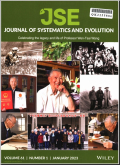Pleistocene range expansions might explain striking disjunctions between eastern Brazil, Andes and Mesoamerica in Leandra s.str.(Melastomataceae)
摘要Leandra s.str.clade has around 200 species nearly restricted to eastern Brazil.Most species in this group are narrow endemics,but a few present striking disjunct distributions between eastern Brazil and Andes or Mesoamerica.Given the predominantly "montane" distribution observed in most Leandra s.str.,we hypothesized that cyclical range expansions during colder Pleistocene periods,followed by local extinctions during warmer interglacial periods,could have shaped the distribution of the disjunct species in this clade.In order to gather support for this biogeographical scenario in a phylogenetic framework,the species that occur outside eastern Brazil were identified,ages of the dispersal events estimated,climatic niche models for the disjuncts were generated,and the climatic envelope of these species compared.Our results place all dispersal events from eastern Brazil to Andes or Mesoamerica during the Pleistocene.Climatic niche modeling indicates a potential range expansion during the Pleistocene colder times for the disjunct species.Although the surpassing of the "dry diagonal" could have been facilitated during glacial periods,this open corridor is an effective barrier for Leandra,given the reduced number of species that dispersed beyond an eastern Brazilian origin.Additionally,the disjunct species do not present significant differences in their climatic envelopes to the non-disjunct species.Our results provide support to a short-dispersion/stepping-stone migration scenario to account for the observed disjunctions in this clade.Range expansions during Pleistocene colder periods followed by local extinctions during interglacial periods could have shaped the distribution of Leandra s.str.
更多相关知识
- 浏览14
- 被引0
- 下载0


相似文献
- 中文期刊
- 外文期刊
- 学位论文
- 会议论文



 换一批
换一批 换一批
换一批



